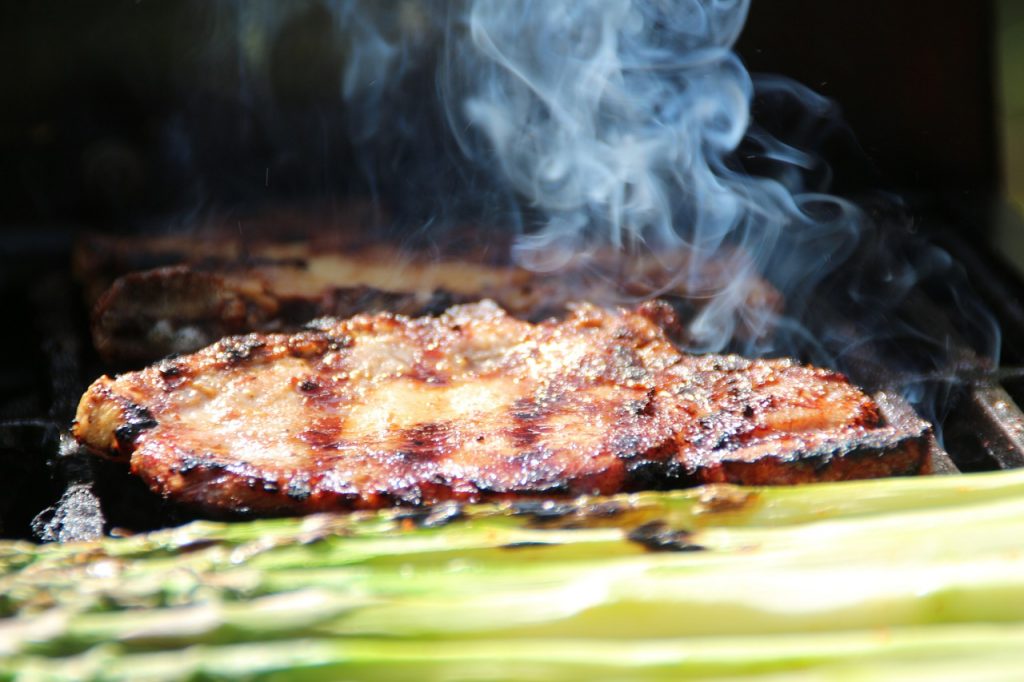The American Barbecue Posted by Gary Locke on Jun 1, 2017 in Culture

It is smoke and sizzle. It is wood and fire and meat. It may be a pit or a drum or a homemade kettle, but it is where the magic happens. Carolina, Kansas City, Texas, or beyond, it’s barbecue American-style.
Let’s get something out of the way immediately. I am not talking about grilling. I have a grill on my deck, and I use it in all seasons, in all conditions, Well, except for strong thunderstorms. But, otherwise, I grill meat, fish, vegetables, and fruit all year. I love it, and I’m pretty good at it. But I do not barbecue. Barbecue is serious business in many parts of the US. This post is about barbecue.
When you grill, the heat always radiates from underneath whatever you are cooking. If you have a standard grill, you can put the lid down while you entertain your guests, or check the evening news. However, don’t wander too far. You’ll be eating shortly.
Barbecue, both a verb and a noun, is only accomplished by cooking long and slowly, with heat and smoke surrounding your food. There are classes and competitions for those who want to become expert at this highly specialized culinary art. There are passionate schools of debate regarding the ingredients and methods of proper barbecue, and woe be to anyone who can’t tell the difference between a sauce and a rub.
Barbecue History
The word barbecue is widely believed to be a mispronounced version of the word barbacoa, describing a rack several feet off the ground, used for cooking, as well as for storing food. It comes to us from the Tanino dialect of the Arawak Indians of the Caribbean and Florida. These natives had no written language that we know of, so the Spanish adopted their own spelling. In 1755, Samuel Johnson included the word in his Dictionary of the English Language, and it now is the accepted spelling.
However, the first known description of barbecue far predates Johnson. The Book of Exodus tells us that God, through Moses, commanded the Israelites to construct a tabernacle for “burnt offerings”. Its description, including fleshhooks, firepans, ash pans, shovels, basins, a grate, and tie downs to attach the animal before the sacrifice sounds an awful lot like today’s barbecue pits.
We know that George Washington enjoyed a good barbecue, spending all night smoking and roasting meat with other men, and he had a special rotisserie for slow roasting in his kitchen at Mount Vernon, Virginia. Southern plantations smoked meat in smokehouses in order to preserve it for the long winters to come, but the slaves who maintained them also were in charge of smoke pits for the roasting of meat for their owners. The practice of barbecuing pork, and serving only the finest cuts to the white landowners led to the expression of living high off the hog.
As freed slaves began to resettle following the American Civil War, their talents as pitmasters traveled with them. One of these men was the now legendary Henry Perry of Shelby County, Tennessee. He settled in Kansas City, Missouri, and quickly established himself as an innovator with his mix of hickory and oak wood for the fire and smoke of his meat, as well as a powerfully spicy, tomato sauce which was basted on. Although barbecue was nothing new to Kansas City, it was Perry’s methodology which was soon widely imitated.
Regional Barbecue
Prepare yourself for some serious controversy. There are significant regional differences in barbecue, and arguments rage over the superiority of one over the other. Here’s a quick guide.
-
South Carolina
German immigrants to South Carolina brought their history of loving mustard to the sauces of the state’s barbecue. Yellow mustard, sugar, and spices are the component features of tangy and spicy pork barbecue in this state.
-
Texas
Forget pork. Texas is cattle country, and slow cooked beef brisket over mesquite wood is the main attraction. Also, dry rubs made from Mexican spices are the preferred method of seasoning, instead of sauces.
-
Memphis
Good news: If you can’t decide between a dry rub or wet and sticky sauces, Memphis has you covered. They gladly serve both, but you can forget about beef here. In Memphis, you will be served a plate of slow cooked pork ribs.
-
Louisiana
Welcome to the land of Cajun-spiced cochon de lait, or whole roast pig prepared with hot sauce and cayenne peppers.
-
Chicago
The windy city is going to serve you sauce-drenched smoky ribs and pork links cooked over a smoldering hardwood fire.
-
Hawaii
Aloha! In the Polynesian-influenced islands of Hawaii you will tuck into kalua, a whole roasted pig cooked in a buried roaster called an imu. A pit is dug, red hot lava rocks are added, then banana leaves to create the smoke, the salt-encrusted pig, more leaves, then a burlap covering is added before the whole thing is buried. Many hours later, the now cooked meat is dug up. E ʻai kāua!
-
Kansas City
Kansas City is the home to huge railyards, where livestock is shipped from all over the country, so you can get any meat served to you here, but expect to find close variations on Henry Perry’s original cooking methods. Hickory and oak-smoked meat is served oozing with fiery tomato sauce goodness.
Personally, I haven’t yet decided which regional barbecue appeals to me. I guess I have to keep trying them all until I decide.
What’s your favorite? Is there another style that I might have missed?

Build vocabulary, practice pronunciation, and more with Transparent Language Online. Available anytime, anywhere, on any device.



